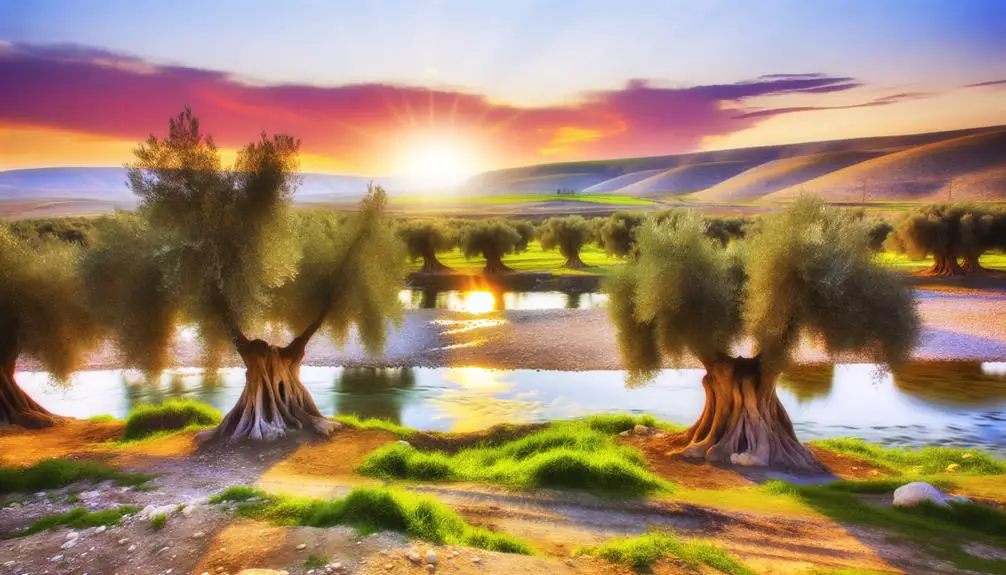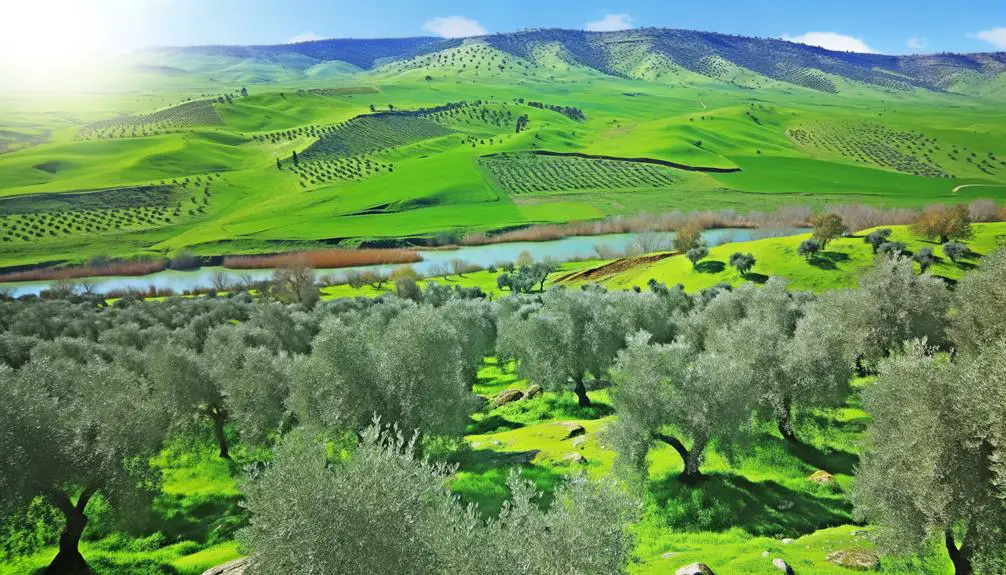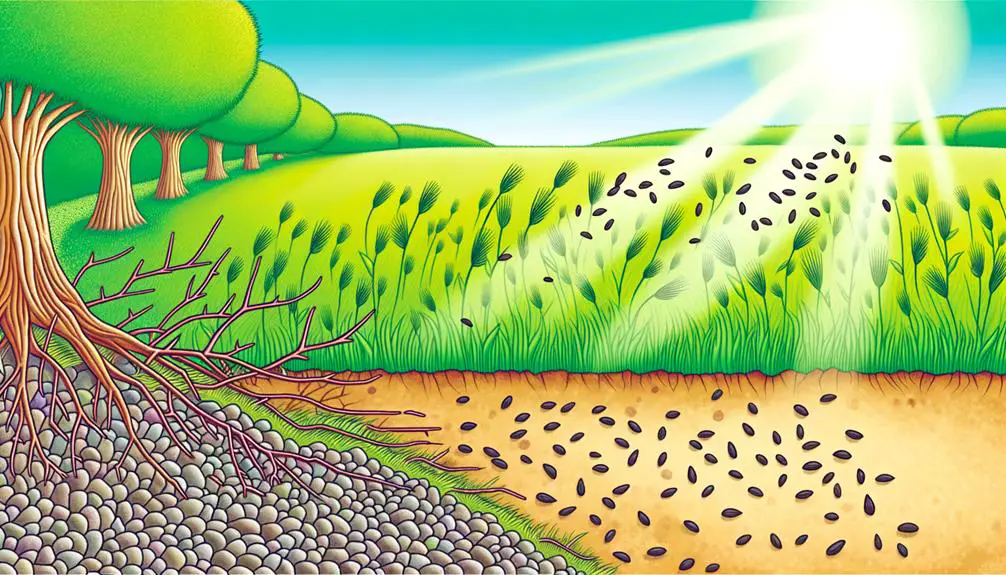Peer into the Bible's portrayal of Earth, a divine canvas of creation, sovereignty, and human stewardship—discover its deeper meanings.

Description of the Earth in the Bible
In the Bible, you'll find that the Earth is portrayed not merely as physical terrain but as a manifestation of divine craft and moral testing ground. Initially depicted as a 'formless void' in Genesis, it emerges through God's command as a structured and life-sustaining creation. This sacred text emphasizes Earth's role in expressing God's sovereignty and human humility; mountains, seas, and skies elicit awe and reverence, underscoring your smallness and God's grandeur. Additionally, themes of stewardship call you to honor and preserve this divine gift. Exploring further into biblical landscapes, you'll uncover deeper layers of spiritual and ethical significance.
Key Takeaways
- Earth is depicted as a creation of God, initially formless and brought to order by divine command.
- It serves as a stage for God's interaction and demonstration of power, such as in the Exodus.
- Biblical texts emphasize the beauty and grandeur of Earth, celebrating it in poetic expressions like the Psalms.
- Earth is portrayed as a realm under divine sovereignty, managed by humans as stewards with sacred responsibilities.
- The concept of a New Earth in Revelation describes a restored, divine presence-filled world without pain or sorrow.
Creation of the Earth in Genesis

In Genesis, the creation of the Earth unfolds through God's commands, illustrating a deliberate and purposeful act that sets the foundation for all existence. Initially, the Earth was a 'formless void,' a phrase that denotes an absence of order and substance, indicative of a cosmos in waiting. This void awaited the Divine timing, a concept that underscores the meticulous and sovereign orchestration of creation. God's voice pierces this formlessness, commanding light into being and subsequently all elements of life as it is revealed.
You might ponder the significance of this narrative structure. It's not merely about the chronological emergence of sky, land, and sea; it's a reflection of divine wisdom. Each step, marked by 'And God said,' reveals that the material world isn't a product of random forces but of a calculated divine will. The repeated declaration, 'And it was good,' emphasizes the functional and aesthetic completeness of each phase.
This deliberate pacing in the Genesis account isn't just a story. It's a theological assertion that all creation, including the Earth, is imbued with purpose and value, established by divine decree. The Earth, hence, isn't merely a stage for human history but a confirmation to divine artistry and intentionality.
Earth's Role in Exodus Narratives
The Earth plays a pivotal role in the Exodus narratives, serving both as a witness and an active participant in the liberation of the Israelites. Under Moses' leadership, the Israelites sought freedom from Egyptian bondage, a journey marked not only by human struggle but by significant earthly phenomena. The landscape itself bore the weight of Pharaoh's defiance and the demands of divine will.
Here are five key ways the Earth influenced and shaped the narrative:
- Plagues: The ten plagues are direct interactions of the divine with earthly elements—water turning to blood and swarms of locusts devastating crops, each plague leveraging the Earth to compel Pharaoh towards liberation.
- Parting of the Red Sea: Perhaps the most iconic, this event where the sea split embodied Earth's active role in delivering the Israelites from capture, showcasing a miraculous manipulation of natural forces.
- Pillar of Fire and Cloud: These phenomena guided the Israelites, demonstrating Earth's environment acting under divine command to direct and protect.
- Manna from Heaven: While heavenly in origin, manna's collection and its daily appearance emphasized the Earth's role in sustaining the Israelites.
- Mount Sinai: The Earth as a site of divine encounter where Moses received the Commandments, further emphasizing the integral connection between divine will and earthly manifestation.
Through these examples, it's evident that the Earth is not just a backdrop but a dynamic character in the Exodus story, deeply woven into the fabric of divine intervention and human history.
Land Descriptions in Leviticus

Leviticus offers detailed guidelines on land use, emphasizing stewardship and sacred responsibilities toward the Earth. As you explore its chapters, you'll find that the text doesn't merely instruct on land ownership; it embeds deep spiritual significance into the management of agricultural resources. The agricultural laws laid out are exhaustive, meticulously defining how the land should rest during the Sabbatical year, illustrating a profound respect for the natural order and cycles of renewal. This sabbatical rest is not just an agricultural practice but a divine command, underscoring the belief that the land itself is a gift from God and must be treated with reverence.
Furthermore, the Priestly boundaries delineated in Leviticus are not just physical demarcations but also moral and ethical borders that govern human interaction with the land. These boundaries signify more than limits; they teach restraint and the importance of sharing resources equitably. In this way, Leviticus advocates for a community-centered approach to land use, where the welfare of the community and the health of the land are inextricably linked. This sacred text challenges you to view land not as a commodity to be exploited, but as a crucial component of a spiritual covenant with the Creator.
Earth in Psalms: Poetry and Praise
As you explore the Psalms, you'll notice how vividly they celebrate the beauty of creation, a theme that elevates the splendor and intricacy of the Earth. This poetic expression is intertwined with a profound sense of human humility before the divine, reflecting an awareness of humanity's place within the broader tapestry of life. Additionally, these verses consistently affirm the sovereignty of God, positioning the Earth not merely as a backdrop but as an active indication of divine authority and intent.
Creation's Beauty Celebrated
How does the Book of Psalms poetically celebrate the beauty of creation through its vivid imagery and expressive language? The Psalms are replete with natural reflections that not only showcase the aesthetic worship of the divine but also elevate the reader's understanding of the Earth's splendor. These sacred hymns encapsulate the grandeur of creation, urging you to see beyond the mundane.
- Vivid Metaphors: Comparing mountains to giants and rivers to dancers.
- Dynamic Personifications: Trees clap their hands, fields jubilate.
- Sensory Language: Descriptions that appeal to the senses, making you almost feel the breeze or hear the rustling leaves.
- Spiritual Symbolism: Natural elements as symbols of God's power and generosity.
- Emotive Tone: Each verse crafted to stir reverence and awe in the heart of the beholder.
Human Humility Expressed
While the Psalms celebrate the grandeur of creation, they also remind us of our modest place within this vast universe. These sacred poems often juxtapose the magnificence of the cosmos with the fragility of human existence, prompting a sense of divine humility and mortal reverence. You're urged to ponder not just the beauty, but also the scale of divine creation, contrasting sharply with human limitations.
Aspect |
Description in Psalms |
Effect on Human Perspective |
|---|---|---|
Earth's Size |
Vast and expansive |
Highlights human smallness |
Sky's Reach |
Boundless and high |
Inspires awe and humility |
Ocean's Depth |
Unfathomable depths |
Emphasizes human finitude |
Mountain's Height |
Majestic heights |
Invokes a sense of wonder |
Human's Role |
Caretakers, not owners |
Cultivates reverence |
This understanding fosters a profound appreciation of one's role in the broader tapestry of life.
Divine Sovereignty Affirmed
Frequently, the Psalms declare the Earth as God's dominion, reinforcing His supreme authority over all creation. You'll find that the poetic verses not only celebrate the beauty of the world but also affirm the sovereign purpose behind it. The Psalms intricately reveal how divine control manifests in both the natural order and human affairs, urging you to recognize and respect this governance.
- Psalm 24:1 – "The earth is the Lord's, and everything in it."
- Psalm 93:1 – Describes God as robed in majesty, having established the world.
- Psalm 95:4-5 – Highlights God's hands forming the earth's depths and mountain peaks.
- Psalm 119:90 – Asserts God's faithfulness through all generations, grounding it in the created order.
- Psalm 47:8 – God reigns over the nations, seated on His holy throne.
Prophets' Views on Earth's Future
As you explore the prophetic scriptures, it becomes evident that the Bible contains profound insights into the future of the Earth. The prophets foretell of end times filled with divine judgments, yet they also offer a vision of hope through the promise of Earth's renewal. This dual narrative invites you to reflect on the balance of warning and redemption that shapes the biblical perspective on the planet's destiny.
Earth's End Times
In the biblical narrative, prophets foretell that the end times will bring dramatic transformations to Earth. You'll encounter descriptions of Tribulation events and apocalyptic symbols that illustrate profound changes. These narratives are not just stories; they serve as a profound, symbolic representation of spiritual and physical upheavals.
To understand the scope, consider these key aspects:
- Seismic shifts: Literal and metaphorical earthquakes signaling the world's remaking.
- Celestial signs: Stars, sun, and moon behaving unpredictably as cosmic harbingers.
- Unprecedented weather: Catastrophic conditions illustrating nature's response to spiritual decay.
- Massive upheaval: Societal and geographical transformations reflecting deep moral and spiritual crises.
- Symbolic imagery: Creatures and phenomena that represent deeper truths about human nature and divine justice.
Divine Judgments Foretold
Prophets' visions reveal that divine judgments on Earth will manifest through precise and transformative events, reflecting the consequences of humanity's actions. These judgments, often depicted as global catastrophes, aren't just random; they're deeply tied to moral consequences. As you explore the prophetic texts, you'll find that each judgment serves as a mirror, reflecting human ethics and their repercussions on Earth.
Prophet |
Vision of Judgment |
Moral Consequence |
|---|---|---|
Isaiah |
Earth laid waste |
Greed and exploitation |
Jeremiah |
Droughts and desolation |
Faithlessness |
Ezekiel |
Cities overthrown |
Injustice and corruption |
These accounts aren't merely historical or mythological; they're warnings. They urge you to reconsider how your actions today might shape the divine responses of tomorrow.
Promise of Renewal
Despite the harsh judgments foretold, there's a compelling promise of renewal for Earth, envisioned by biblical prophets as a profound transformation and restoration of balance. This vision aligns closely with principles of environmental stewardship, emphasizing a harmonious relationship between humanity and the natural world. The prophets' insights provide you with a blueprint for sustainable living, deeply rooted in spiritual wisdom and Covenant symbolism.
- Restoration of Eden: Reestablishing the purity and bounty of nature, akin to the Garden of Eden.
- Righteous Rule: Governance that prioritizes ecological balance and justice.
- Renewed Hearts: A transformation in human hearts towards greater care for creation.
- Prophetic Visions: Detailed predictions encouraging a return to God's original plan for Earth.
- Covenant Renewal: Symbolic acts reinforcing the sacred responsibility to protect and nurture the Earth.
Jesus' Teachings on Earthly Stewardship
Jesus' teachings emphasize that stewardship of the Earth is a sacred responsibility entrusted to humanity. You are called to act as guardians of this planet, reflecting divine care through your actions. This stewardship isn't just about conservation but involves active engagement in maintaining the balance of creation. The notion of "green commandments" can be seen as guiding principles derived from Jesus' broader ethical teachings, urging you to protect and sustain the Earth's resources. Similarly, "sustainable parables" might reinterpret his stories to highlight themes of sustainability and ecological mindfulness.
Here's a structured overview of key concepts related to Earthly stewardship in Jesus' teachings:
Concept |
Description |
Biblical Basis |
|---|---|---|
Green Commandments |
Ethical guidelines promoting environmental responsibility |
Implicit in teachings on love and care for creation |
Sustainable Parables |
Stories illustrating principles of sustainability |
Interpretative extension of parables emphasizing stewardship |
Divine Care |
Belief that Earth is a creation of God, deserving reverence |
Genesis; Psalms |
Human Role |
Humanity's duty to maintain and protect Earth |
Genesis stewardship mandate |
Active Engagement |
Encouragement to participate in sustainable practices |
Parables calling for action and mindfulness |
Through these lenses, you're invited to reevaluate your interaction with the environment, recognizing your pivotal role in its preservation and enhancement. Jesus' model offers not only a theological but also a practical blueprint for ecological engagement.
Earth in the Parables of Jesus

In several parables, the Earth serves as an essential backdrop that illustrates broader spiritual lessons about stewardship and responsibility. You'll find that Jesus frequently employed agricultural metaphors to convey the principles of the Kingdom of God. These parables not only reflect the agrarian society of His time but also imbue the physical landscape with rich spiritual significance. The narrative soil Jesus tills is fertile with teachings on diligence, foresight, and the nurturing of one's spiritual life.
Consider these parables and their connection to the Earth:
- The Parable of the Sower: Earth's soil becomes a metaphor for the receptivity of hearts to the gospel, highlighting the varied outcomes based on soil quality—path, rocky, thorn-infested, and good.
- The Parable of the Weeds: Here, the field represents the world itself, where good and evil grow together until the harvest, symbolizing judgment and separation.
- The Parable of the Mustard Seed: A small seed grows into a large tree in the Earth, symbolizing the expansive growth of God's Kingdom from small beginnings.
- The Parable of the Talents: This story uses the metaphor of the Earth yielding increase, emphasizing the importance of spiritual diligence and productivity.
- The Parable of the Fig Tree: Earth's seasonal cycles illustrate the urgency of recognizing spiritual signs and readiness.
Through these parables, Jesus not only teaches about the importance of a spiritual harvest but also places profound responsibility on His followers to steward the Earth thoughtfully and watchfully.
New Earth in Revelation Imagery
The imagery of a New Earth in Revelation symbolizes a profound transformation, offering a vision of restoration and renewal for creation. You'll find that this vision is intricately woven with apocalyptic symbols, which serve to communicate the radical nature of God's redemptive plan. As you explore further, you'll notice the depiction of the Heavenly city, the New Jerusalem, descending from the sky. This isn't just a literal city but a symbol of divine presence and the eternal dwelling of God with humanity.
These visions in Revelation are steeped in rich symbolism meant to inspire hope and anticipation. The New Earth, devoid of the former things—pain, sorrow, and death—promises a reality grounded in righteousness and divine justice. It's important for you to understand that these images aren't just futuristic; they carry a current message of hope and a call to live in light of this coming reality.
As you reflect on this, consider how the apocalyptic symbols and the portrayal of the Heavenly city aren't merely to be understood literally. They're deeply symbolic, urging you to look beyond the present world and towards a transformed future where heaven and earth converge in a restored creation.
Frequently Asked Questions
How Do Biblical Cosmologies Compare With Modern Scientific Understandings?
Biblical cosmologies, rooted in ancient texts, contrast starkly with scientific views based on empirical evidence. You'll find that this ancient-modern dichotomy enriches your understanding of cosmological interpretations across different eras and cultures.
Are There Biblical References to Other Planets or Extraterrestrial Life?
The Bible doesn't explicitly mention other planets or extraterrestrial life. However, alien interpretations and celestial speculations arise from ambiguous texts, suggesting scholars view these passages with both reverence and critical analysis.
What Cultural Influences Shaped Biblical Descriptions of the Earth?
Ancient trade routes and regional mythologies profoundly influenced cultural perceptions, shaping the biblical descriptions you read today. They interwove diverse narratives, enriching the text's depiction of our world's spiritual and physical dimensions.
How Do Biblical Earth Descriptions Influence Contemporary Environmental Policies?
Biblical earth descriptions subtly nudge contemporary environmental policies, don't they? Your theological stewardship morphs into policy integration, encouraging a blend of ancient wisdom with modern sustainability efforts, fostering a reverently analytical approach to ecological preservation.
Does the Bible Address the Concept of Earth's Sustainability?
Yes, the Bible addresses Earth's sustainability through concepts of divine stewardship and creation care, urging you to responsibly manage natural resources, reflecting a reverence for life and a commitment to future generations.



Sign up